
"Report on the Last Two Cholera-Epidemics of London, as Affected by the Consumption of Impure Water"
addressed To The Rt. Hon. The President Of The General Board Of Health [William Cowper], By The Medical Officer Of The Board [John Simon].
[Thanks to Nigel Paneth for loaning us his copy so we could re-scan the tables.]
To the Right Hon. William Cowper, M.P., [etc.]
General Board of Health,
13th May 1856.
Sir,
Having at your desire examined certain statistical materials, lately compiled in this Department, I now beg leave to report to you thereon; premising only a few words on what gave rise to that compilation.
You will probably remember that, during the late epidemic of cholera, Sir Benjamin Hall (then President of this Board) convened a Medical Council to advise him in relation to the public health; which Council deputed certain of their number, as a Committee for Scientific Purposes, to suggest the institution and review the result of such inquiries as might seem likely to elucidate the nature of the prevailing disease; and that the Committee thus originated (consisting of Dr. Arnott, Dr. Baly, Dr. Farr, Professor Owen, and myself) had the honour of presenting to Sir B. Hall, on the 14th July last, a final Report on investigations which were then concluded.
In one important particular this Report was of necessity incomplete. Our Committee had thought it of importance to inquire as fully as possible into the sanitary influence of different qualities of water-supply; especially into the power of unclean drinking-water to aggravate the epidemic ravages of cholera. With this view--under circumstances which offered peculiar opportunities of attaining a conclusive result--we had suggested a particular statistical inquiry. Copious details of information had been in consequence collected; but these could not be brought into an [3/4] available form against the time when our Report was made, and we were therefore reluctantly obliged to construct it without reference to them.
These are the materials, which--at length completed according to the intention of the Committee--you have done me the honour of referring for my Report. Accordingly I beg to lay before you the subjoined summary tables; which, as embodying their more important results, constitute the definite reply to a great sanitary question: and in proceeding to comment on these, I revert to that point of view in which the plan of investigation was first conceived.
As often as Asiatic cholera had been epidemic in London, it had been observed to prevail, with especial severity, in certain registration-districts on the south side of the river; viz., in St. Saviour's, St. Olave's, and St. George's, Southwark, in Bermondsey, Newington, Lambeth, Wandsworth, Camberwell, and Rotherhithe.
It is to these nine districts that the inquiry was addressed; and they suggested themselves as the best field for observation, not only because of their high epidemic mortality, but because in them, if anywhere in London, there was to be gathered conclusive evidence for a verdict on the matter at issue;--for a verdict, which should acquit or inculpate certain qualities of water-supply, as bearing on the local prevalence of cholera.
Commonly, in attempting such inferences, the inquirer is baffled by difficulties, which render exact conclusions impossible: for populations drinking different waters will often be living in different circumstances of wealth, comfort, occupation, cleanliness, soil, climate. But in the present case there was a singular freedom from such sources of embarrassment. Throughout the investigated districts masses of similar population were dwelling side by side; and the exterior influences which affected them were, with a single exception, apparently identical.
The one varying condition was the quality of water, as consumed in different households. For throughout those southern districts of London, two great competing water-companies had in past times canvassed house by house for customers; their rival mains were still branching within the same area, often running parallel in the same streets; and during the late invasion of cholera (though now happily the difference has ceased) these two systems of pipes were respectively charged with very different waters. [4/5]
If, during the epidemic prevalence of cholera, persons consuming pure water are less liable to suffer the disease than persons consuming foul water, surely there might be expected some striking difference between the death-rates of two populations respectively drinking from the Thames at Ditton and from the Thames at Battersea.
And such were the sources of supply of the two companies referred to; the Lambeth Company pumping from the higher part of the river, the Southwark and Vauxhall Company from the lower; the former furnishing as good a water as any distributed in London, while the latter was purveying perhaps the filthiest stuff ever drunk by a civilized community.
In the Report of the Committee for Scientific Inquiries, the contrast of these waters was shown. Microscopical and chemical observations were adduced, as proving the almost incredible foulness of that supplied by the Southwark and Vauxhall Company; how it was not only brackish with the influence of each tide, but contaminated with the outscourings of the metropolis, swarming with infusorial life, and containing unmistakeable molecules of excrement.
In reference to the comparison which had to be made, it is especially important to observe, that the tenantries, of these two great companies were not set on different parts of the South London area, each isolated from the other. On the contrary, the two populations were, so to speak, mutually interfused. Of 31 sub-districts into which the large space is divided, only 8 were monopolised by a single water company; while of the remaining 23 each was supplied, sometimes in equal proportion, by one company and the other.
It likewise deserves notice, that the materials for comparison were not on a small scale. It was not village against village. The investigated districts comprise about a fifth of the entire population of London. They contained in 1849 about 466,000 persons, and in 1854 about 511,000.
When, at the latter period (after the termination of the cholera-epidemic) the water-supply was investigated, nearly 25,000 houses could be shown to derive their water-supply from the Lambeth Company; nearly 40,000 from the Southwark and Vauxhall Company; while regarding the remainder (many supplied by pumps and wells) no certain information could be got. [5/6]
Such were the materials of comparison, so like--except for the one unlikeness of water-supply--and at the same time, so ample, as to promise unique facility for determining the matter at issue; and the very decisive results which have been obtained justify the hope with which this laborious inquiry was commenced.
In the 24,854 houses supplied by the Lambeth Company, comprising a population of about 166,906 persons, there occurred 611 cholera deaths, being at the rate of 37 to every 10,000 living. In the 39,726 houses supplied by the Southwark and Vauxhall Company, comprising a population of about 268,171 persons, there occurred 3,476 deaths, being at the rate of 130 to every 10,000 living.
The population drinking dirty water accordingly appears to have suffered 3½ times as much mortality as the population drinking other water.
I am not aware of any fallacy which can much affect this comparison; and I am the more persuaded of its substantial justice, as I find on detailed examination that the same general results are represented (see Tables II. and III.) in almost every separate line of the figures.
Further, if the number be reduced, by omitting from the comparison 11 sub-districts which are almost monopolised by the Southwark and Vauxhall Company; so that there remain (see Table, No. IV.) 20 sub-districts, with a population of more than 365,000 persons, almost equally supplied by the two companies; it is still found, nearly as before, that the consumers of the cleaner water suffered not a third as much as their neighbours.
Perhaps the real significance of these totals is best shown by an examination of the details embodied in them; and, for a convenient instance of this kind, there has been prepared a table (No. V.) which illustrates, in respect of 45 streets, the method and materials of comparison. In every one of these streets, the mains of the rival companies run side by side, each supplying its own proportion of houses; so that, although in any one street the number of houses may be unequally divided between the companies, the respective totals are equal--1,517 houses supplied by the Lambeth, 1,517 by the Southwark and Vauxhall Company. [6/7]
Here then are 3,034 houses, with about 20,000 inmates: divisible, as it were, into two populations, each the exact counterpart of the other, except in the one particular of water-supply. One of these populations lost 57 persons by cholera; the other lost 164.
Hitherto it has been shown only that in the epidemic of 1853-4, a very large population drinking foul water suffered from cholera more than three-fold as much as a similar population drinking cleanly water.
But this evidence is only a part of the case. It admits of being greatly strengthened by a second group of facts, which the statistical tables exhibit. For the death-registers have been analysed with a view not only to the epidemic visitation of 1853-4, but also to that of 1848-9. It was thought proper to see how far any discoverable influence of foul water had been constant to both occasions; and this comparison is of singular interest for our purpose, because the Lambeth Company, which in 1854 gave the superior water, was in 1848-9 purveying even a worse supply than that of the Southwark and Vauxhall Company.
It has already appeared that the tenantry of the Lambeth Company (a population of 166,906, comprised in 24,854 houses) lost by the epidemic of 1853-4, 611 persons. By the epidemic of 1848-9, in the same houses (or rather, in as many of them as then existed) the deaths were 1,925.
The earlier figures showed that this population suffered in 1853-4 not a third as much as its neighbours: the present figures give the further fact--that it suffered also not a third as much as at the time of its unreformed water-supply.
On the other hand, the Southwark and Vauxhall Company, which pumped an impure water in 1848-9, pumped even a worse water in 1853-4; worse, because the larger population and more extended drainage of London had given it a denser infusion of sewage, and a more revolting unfitness for drink.
Accordingly, in 1853-4, their tenantry suffered 3,476 deaths, against 2,880 registered in 1848-9 for as many of the same houses as were then existing. In this large increase, half would probably be the utmost proportion for which new houses could account; so that on this assumption, although the general metropolitan pressure of the epidemic in 1853-4 was considerably lighter than in 1848-9, the [7/8] houses supplied by the Southwark and Vauxhall Company in the late epidemic suffered probably 10 per cent higher mortality than the same houses in 1848-9.
In short (corrected, as far as possible, for difference of time) the comparison of the two populations in the two epidemics stands thus:-- the one population (notwithstanding a generally lighter invasion of the disease) the cholera death-rate rose from 118 to 130: in the other it fell from 125 to 37.
And what was the only discoverable difference of condition between these two populations? The one had improved its water-supply to comparative excellence; the other drank from even a filthier source than before.
To these facts may be added others not yet adverted to. In collecting the materials for tabulation, it was thought necessary to extract from the register, not only the entries of death by cholera, but likewise those of death by diarrhœa; and the latter information has been tabulated in precisely the same manner as the former.
Reference to Tables VI. and VII. will show that the results obtained in this branch of the investigation repeat on a smaller scale1 the conclusions already suggested.
In houses supplied in 1854 with water by the Lambeth Company, the death-rate from diarrhœa per 10,000 of the population was 21; in houses supplied by the Southwark and Vauxhall Compnny, it was 33. Or, the population drinking foul water suffered 57 per cent more diarrhœal mortality than the population drinking other water.
And in comparing, with every possible correction, the respective sufferings of these two populations in the two epidemics, we find that on the second occasion diarrhœa, like cholera, pressed more heavily on the one population, though much more lightly on the other. Among the tenantry of the Lambeth Company the diarrhœal death-rate, which in 1853-4 was 21, had in 1848-9 been 29: among the tenantry of the Southwark and Vauxhall Company this rate, which in 1853-4 was 33, had in 1848-9 been only 27. [8/9]
In some elements of these comparisons there may be trifling sources of error; but none, I believe, which can modify--much less vitiate--the general result.
Scarcely under any circumstances, indeed, are the physiological sciences susceptible of greater certainty, than that which seems here to be justified.
An experiment, at which mankind would have shuddered if its full meaning could have been prefigured to them, has been conducted during two epidemics of cholera on 500,000 human beings. One half of this multitude was doomed in both epidemics to drink the same fecalized water, and on both occasions to illustrate its fatal results; while another section-freed in the second epidemic from that influence which had so aggravated the first, was happily enabled to evince by a double contrast the comparative immunity which a cleanlier beverage could give.
By this experiment, it is rendered in the highest degree probable, that, of the 3,476 tenants of the Southwark and Vauxhall Company who died of cholera in 1853-4, two-thirds would have escaped if their water-supply had been like their neighbours'; and that, of the much larger number--tenants of both companies--who died in 1848-9, also two-thirds would have escaped, if the Metropolis Water Act of 1852 had but been enacted a few years earlier.
The above conclusions rest on so large a basis of facts, that I venture to believe they will be accepted as the final solution of any existing uncertainty as to the dangerousness of putrefiable drinking-water during visitations of epidemic cholera; and pathologists will probably admit that the definite proof of hurtfulness, thus established in respect of that one disease, may in principle be extended to the doctrine of other kindred affections.
To many it may appear that such proof needs not to have been sought; for that no reasonable person could ever seriously have doubted as to the hurtful tendency of the water lately distributed by the Southwark and Vauxhall Company. Such reliance on existing convictions would, however, have been misplaced. Not long ago, when there was last a public hearing of this company, its Directors declared the water to be "unexceptionably good;" its Chairman, contending that the works were capable of distributing from the Thames at Battersea a supply [9/10] "inferior in no appreciable degree to the stream in any part of its course," remonstrated against any change of source, as "a wholly uncalled-for expenditure of capital;" and gentlemen of deserved eminence as chemists (though perhaps not entitled to speak with equal authority on the causation of disease) were found willing to express opinions both that this water, nourishing a population of animalcules, would "not be noxious" to health, and that "we cannot" in any part of the world connect the ravages of cholera "with the quality of the water" consumed.2
Even last year when our Committee for Scientific Inquiries had the honour of reporting on the materials then collected, we felt bound to express ourselves with some reserve;3 not because our opinions were divided as to the probable danger of drinking such water as that in question, but because, from the absence of circumstantial proof, we were unable to speak of the danger as an evil demonstrated and measured. [10/11]
Nor have later publications hitherto rendered our knowledge more precise. An interesting contribution has indeed been made in the results of a local inquiry, conducted with much care and ability by a Committee of the Vestry of St. James's, Westminster, into the circumstances of that remarkable outbreak of cholera which happened in the neighbourhood of Wardour Street4; and the conclusion which that Committee reported was to the effect, that, in their unanimous opinion, "the sudden, severe, and concentrated outbreak was in some manner attributable to the use of the impure water of the well in Broad Street." While, however, it cannot be doubted that the evidence collected by that Committee strongly tends to justify their opinion, other and obvious facts give to the imputed operation at least an exceptional character. Bad as was the produce of the Broad Street well,--containing the results of organic decomposition filtered through but scanty thickness of surrounding soil--this quality of water was not peculiar to it. Generally through London, such must be the condition of superficial well-waters; everywhere filtering from a dangerous proximity to cesspools and sewers; everywhere loaded with nitrates or ammonia; everywhere containing evidence that they represent the drainage of a great manure-bed; and everywhere liable at any moment to contain excremental matter only imperfectly oxidised. In London no comprehensive inquiry could be made into the influence of these well-waters; but almost at the same time that the above investigations were in progress about Soho, others riot less elaborate were proceeding at Munich, as part of a general inquiry under direction of the Bavarian Government. The circumstances of the two cases are so far similar, that the water-supply of that capital, as of London, is of various qualities--part brought from a distance, part derived from intramural wells which are liable in no common degree to the impregnations just adverted to; yet in comparing the cholera mortality of populations thus differently supplied, the distinguished Professor who conducted the inquiry found himself unable to attribute to the well-waters any causative relation to the epidemic which had so severely prevailed in the town.5 [11/12]
But while, on the above showing, it must be conceded that for scientific purposes the definite information embodied in the following tables is of no superfluous kind, it may perhaps be objected that the practical application is less obvious, and that the inquiry has been instigated in a matter of past interest. For, since the epidemic of 1853-4, the Southwark and Vauxhall Company, in obedience to the Metropolis Water Act, has abandoned its former very objectionable source of supply, and for the last few months has been distributing a water, nearly or quite identical in quality with that here spoken of as furnished by the Lambeth Company.
This is, indeed, a very satisfactory fact; which, if the final purpose of the investigation had related only to persons suffering from that particular supply, would have superseded all necessity for the present Report.
But the question is of larger scope. Whether water can securely be drunk from rivers polluted by urban drainage, interests more or less every part of the country; and whatever facts can terminate this doubt, bear upon every plan for the water-supply of a population, and upon every plan for the drainage of a town.
Not even London can in this respect afford to consider itself safe against the danger which seems to have been removed from it. Lower than Teddington Lock, indeed, the Thames may not be used as a source of supply; but above that point there dwell beside the river or its tributaries very considerable urban populations; and hitherto the Legislature has not provided against any pollution of refuse which these communities may drain into the stream. At present, perhaps, the mischief is not great; the population is scattered; the drainage incomplete; the admixture, as compared with the volume of the river, almost insignificant. But whatever at this moment may be the amount of the evil, undoubtedly it tends day by day to increase; and that reform, which the Act of 1852 purported to accomplish, remains but imperfect and precarious while those river-side populations exercise a right of sewerage into the drinking-water of London.
It is, indeed, indispensable for the healthiness of towns, that house-drainage should be universally adopted, and that its currents should rapidly discharge themselves beyond the inhabited area. But the advantages thus to be gained [12/13] will suffer a serious counterpoise, if they can be purchased only at the cost of making the sewerage-outfall into rivers; if the change must be, from an unwholesome house to a polluted water-source; if that which would have been poison to inhale is to return as poison to drink.
Between these alternatives, it is greatly to be feared, lies the present choice of many considerable populations. Town drainage has been executed of late years, with too little recognition that its accomplishment, however successful, represents only part of a great problem. From it there results the production, as it were, of a novel commodity; valuable, if at the right time it can be at the right place, but otherwise valueless and baneful; for in default of that market which only good organization can create, the nearest water-course has to be fouled with what might enrich the fields. Even apart from such new pollution, it rarely happens that rivers are first-rate sources of supply: but they are often the easiest of application; and communities living along their course will generally overlook the worse quality for the sake of the cheaper price. Often therefore as town-drainage extends, successive populations adown the stream get worse and worse water to drink; till the evil at length attains those large and dangerous dimensions which, in respect of a single water-supply, it has been the object of this investigation to trace.
From the sanitary dilemma which these considerations suggest, the only possible escape seems to lie in the organization of means for the systematic agricultural employment of sewage.
Hence it is greatly to be hoped that the engineering genius and commercial enterprise of the country may render such means available and lucrative for all urban populations. But, provisionally, it seems important to determine, whether convenient appliances, exist for the so-called disinfection of sewage; and whether it would be expedient to enforce their adoption, as a restraint on the otherwise universal tendency towards draining putrefiable refuse into the drinking-waters of the country.
In conclusion, I beg to guard this Report against the misapprehension to which so fragmentary a scientific discussion is liable. The inquiry has of necessity been restricted. It did not pretend to determine whether putrefiable drinking-water is a stronger or a weaker morbific influence than impure air or [13/14] defective nourishment. Simply, it asked whether in certain large populations, breathing the same atmosphere, comprehending the same classes, and averaging the same habits of life, the fatal disease had been more prevalent among the drinkers of foul water than among the drinkers of clean water.
The answer has been affirmative. The cholera-mortality of the former class was more than three-fold that of the latter.
The value of this result rests, of course, on the assumption that other influences of disease (whatever they may have been) were equal in the populations compared. For aught that appears to the contrary, it may be true that in every individual case of the 15,212 deaths inquired into, the sanitary arrangements of the house (apart from the quality of its water-supply) were defective. But this would not affect the argument of the Report: for there is no reason to suppose that such defects would be on the average unequally distributed between the two great totals of intermixed population respectively supplied by the two Companies: nor, especially, is it within the limits of reasonable supposition that throughout a continuous urban plan of seventy thousand houses, the removal of sanitary defects during five years should have been effected exclusively, as it were, on alternate houses and alternate streets, according to the accident of their water-supply.
So, too, among the sufferers there may have been a large proportion of poverty, with its attendant defects of nourishment; but this influence also must be supposed to have been impartially distributed between the tenantries of the two water-companies.
The present contribution therefore aims only at giving a more exact knowledge of one cause, not at gainsaying the existence of other causes. "The doctrine of epidemic cholera which has gained almost universal acceptance, does not affect to explain what may be that power--the exciting cause of the epidemic manifestation--which at intervals of time has forayed from place to place about our globe, sometimes vaguely spreading over a widened area, sometimes seeming to move in more defined procession, and which now for the third time has shed its fatal influence on our land. But with this mystery still unsolved, there has grown more and more into shape a doctrine which is both intelligible and practical; that the undiscovered power in its wanderings acts after the manner [14/15] of a ferment, that it therefore takes effect only amid congenial circumstances, and that the stuff out of which it brews poison must be air or water abounding with organic impurity."6
It is only to a part of the above doctrine that the preceding pages immediately refer: but to this part they give a new proof, and to the remainder an indirect confirmation.
It entirely consists with the facts here set forth to maintain that, under the specific influence which determines an epidemic period, fecalised drinking-water and fecalised air equally may breed and convey the poison; and that this, whether in one vehicle or the other, may be expected to prevail most forcibly against the feeble and ill-nourished parts of a population.
I have the honour to be, Sir,
Your obedient humble Servant,
John Simon.
1. It must be remembered that diarrhœa, unlike cholera, is always present in this country, and that some proportion (hitherto undetermined) of its total amount is irrespective of local sanitary conditions. If air and water were ever so pure, there would still be occurring a certain mortality from diarrhœa, due to tubercular and other irritations of the intestinal canal.
2. See Minutes of Evidence taken before the Select Committee on the Metropolis Water Bill, August 1851; Return to Inquiries of Metropolitan Sanitary Commissioners, 1850; and Remarks on the Water-Supply of London by Sir W. Clay, Bart., M.P., Chairman of the Grand Junction and Southwark and Vauxhall Companies, December 1849.
3. "We do, however, attach very great importance to the fact, that nearly all the waters consumed in London show a remarkable aptitude to develop low forms of animal and vegetable life; but this importance belongs, in our judgment, not to any direct influence exerted by such organisms on our own, but to the indications which their development affords that the waters wherein they grow are fraught with dead organic impurities.
"The admixture of decomposing organic matter in the water-supply of the Metropolis being attested equally by chemical analysis and by the microscopical evidence just adduced, we do not hesitate to speak of this contamination as one that may have exercised great influence on the spread of cholera among the population. The general history of this disease establishes its infinite preference for localities that are fœtid with organic impurity; and it is impossible to conceive either any specific chemical changes arising in the air of a district, or any morbid action excitable by it in the living body--such changes or such action being due to its contamination by dead organic admixture--without recognizing that the water of the district likewise--great solvent of air as it is--must, if similarly polluted, be liable to undergo the same alteration, and to originate the same effects, as the atmosphere around it.
"The present state of scientific knowledge does not justify dogmatic assertions on this subject; but there are reasons for believing, in respect not only of cholera, but of many kindred diseases, that the means and agencies of morbid infection stand in intimate relation to decaying animal products within and without the body; and the slightest taint of organic decomposition within the drinking-water of a large population therefore constitutes a danger which we cannot but regard with as much alarm as disgust."--Report of the Committee for Scientific Inquiries; pp. 47, 48.
4. Report on the Cholera Outbreak in the Parish of St. James, Westminster, during the Autumn of 1854; presented to the Vestry by the Cholera Inquiry Committee, July 1855.
5. Untersuchungen und Beobachtungen über die Verbreitungsart der Cholera; von Dr. Max Pettenkofer, München, 1855.
6. Report of the Committee for Scientific Inquiries in relation to the Cholera Epidemic of 1853-4; p. 48.
[17]
illustrating the London Cholera Epidemics of 1848-9 and 1853-4, in their relation to the Quality of Water-Supply.
I. Synopsis of Results -- p. 19.
II. Houses, Population, Water-Supply, and Cholera-Deaths in the nine Surrey Districts of London -- p. 20.
III. The same information, analysed according to the thirty-one Sub-districts included -- p. 22.
IV. So much of the same information as relates to five Districts (or twenty Sub-districts) supplied in almost equal proportions by the two Water-Companies in question -- p. 26.
V. Cholera-Deaths in 3,034 Houses, supplied by the two Water-Companies in equal proportion -- p. 28.
VI. Houses, Population, Water-Supply, and Diarrhœa-Deaths in the nine Surrey Districts of London -- p. 30.
VII. The same information, analysed according to the thirty-one Sub-districts included -- p. 32.
[17/18]
In the Surrey districts of London the aggregate population of 1853-4 probably exceeded that of 1848-9 by about a tenth part. In the absence of precise information it may be assumed as nearly true, that the number of houses there had increased in the same proportion, the average population per house remaining constant at 6.7; and that this increase had told equally on each of the three classes of houses distinguished in the Tables; viz., that of the houses and population supplied in 1853-4 by the Lambeth Company, about one eleventh part was non-existent in 1848-9; that similarly, of the houses and population supplied in 1853-4 by the Southwark and Vauxhall Company, about one eleventh part was non-existent in 1848-9; that similarly, of the houses and population supplied in 1853-4 from "unknown sources," about one eleventh part was non-existent in 1848-9.
Independently of this increase of population, the two companies increased their tenantry between the two epidemics. Their opposition had ceased, and they did not exchange customers; but many houses which in 1853-4 were returned as supplied by the Lambeth Company, or by the Southwark and Vauxhall Company, were in 1848-9 dependent on "unknown sources."
There are not materials for making with perfect accuracy a second distribution of the population according to its water-consumption in 1848-9; and, therefore, the argument of the Report has been so constructed as to avoid this somewhat speculative ground.
The following is all which admits of being definitely stated with respect to the population supplied with water from "unknown sources." In the epidemic of 1853-4, over and above the 64,580 houses verified as supplied by the two great water-companies, there were certain other
houses (of uncertain number) which furnished 1,436 cholera deaths. In the epidemic of 1848-9 in these same houses, or rather in the about 10-11ths of them probably then existing, there were 1,760 such deaths; so that, treating this population like the more definite populations spoken of in the Report, we find its per-centage of cholera mortality, in 1853-4, fully a fourth lighter than in 1848-9. This difference nearly corresponds to that which has been calculated for the Metropolis generally, and which has been ascribed to a milder visitation of the epidemic cause. From it, of course, no conclusion can be drawn relatively to the populations itself. Nearly all may have been drinkers of well-water; or many may have been unacknowledged debtors to the supply of the Lambeth Company. But whatever may have been the cause of their lessened suffering, it contributes, by contrast, to expose that opposite influence which was operating within the same districts on the tenants of the Southwark and Vauxhall Company.
(click on picture to view larger image)
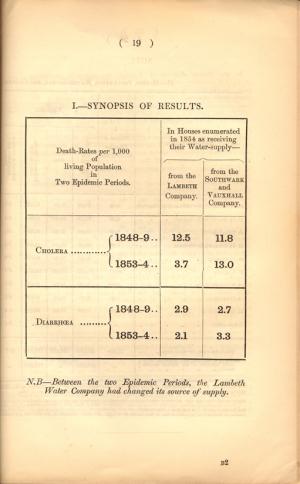
[Click on picture to view larger image--image is large, download may be slow.]
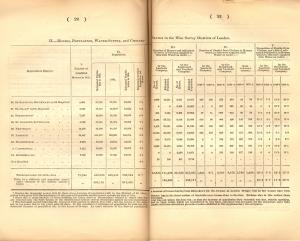
[Click on picture to view larger image--image is large, download may be slow.]
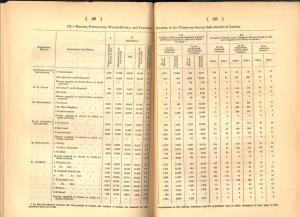
[Click on picture to view larger image--image is large, download may be slow.]
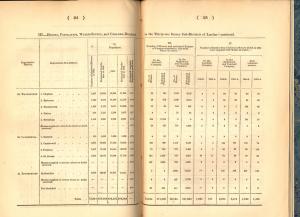
[Click on picture to view larger image--image is large, download may be slow.]
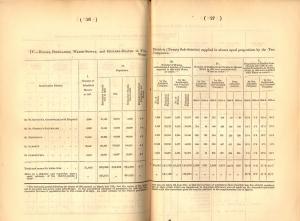
[Click on picture to view larger image--image is large, download may be slow.]
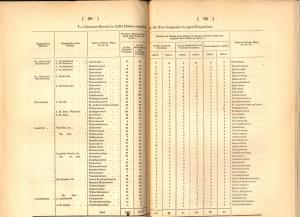
[Click on picture to view larger image--image is large, download may be slow.]
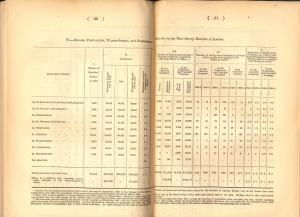
[Click on picture to view larger image--image is large, download may be slow.]
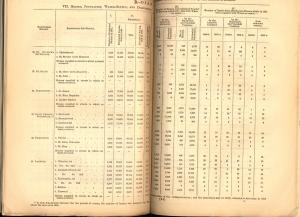
[Click on picture to view larger image--image is large, download may be slow.]
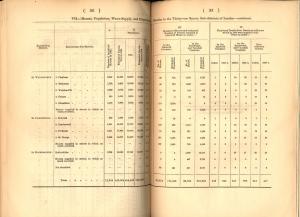

 Home
Home